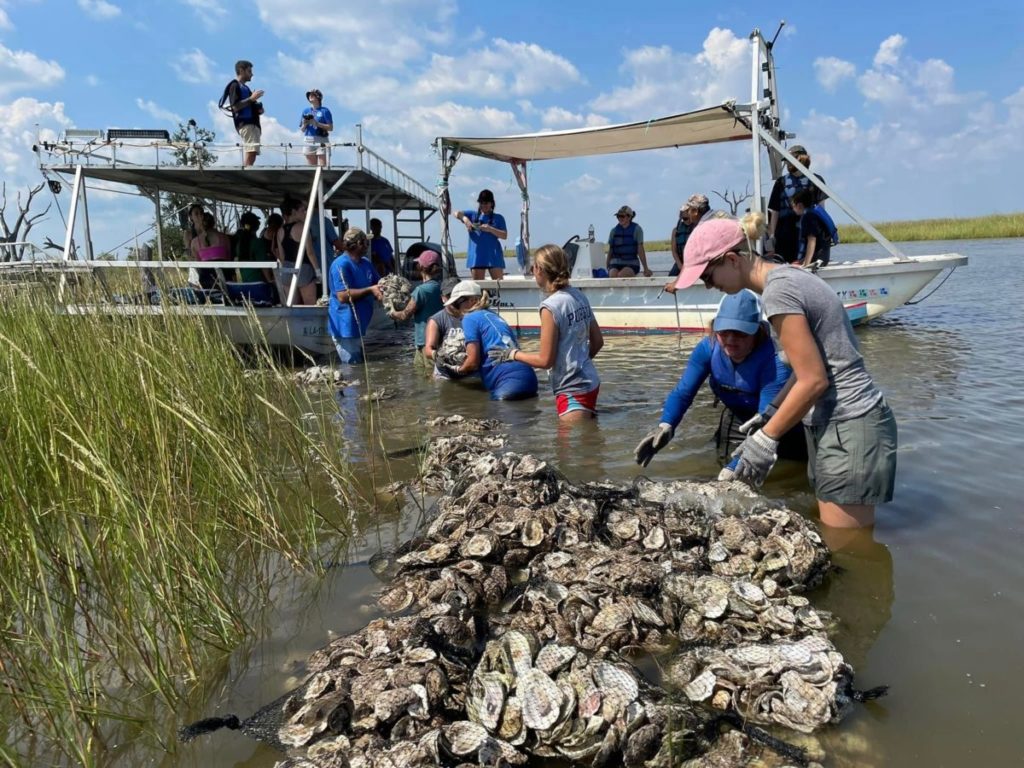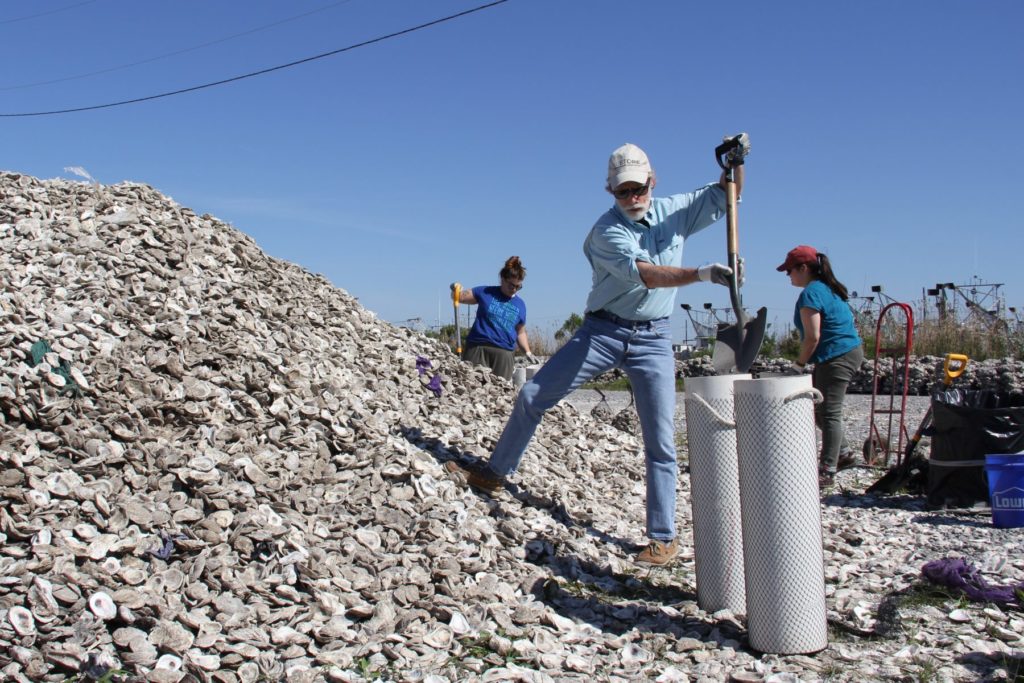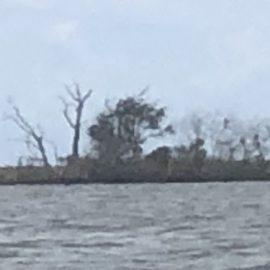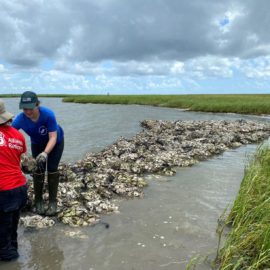
Photo courtesy of Coalition to Restore Coastal Louisiana
This is a different slant on what has been posted before
For Theresa Dardar and her husband Donald, a boat ride through the picturesque Bayou Pointe-aux-Chenes and surrounding marsh in Southeast Louisiana has become a painful reminder of what’s been lost. As Louisiana’s coast disappears, important cultural sites like their ancestral tribal mounds are being swallowed up. “It’s heartbreaking,” said the Dardars, who are leaders in the Pointe-au-Chien Indian Tribe. For years, members of this Indigenous community felt helpless as they watched chunks of sacred land drop into the water. These structures, built by Native peoples and considered spiritual centers, are older than Stonehenge or the ancient pyramids in Eqypt. “Our ancestors made the mounds, and we can’t stand by while they are washed away,” said Theresa Dardar, who added that the tribe’s presence dates back hundreds of years. “Some of it is already gone. This is all part of our ancestry. They became part of us and all our tribal members. So we have to protect them.” To help protect the historic mounds, the Pointe-au-Chien Tribe partnered with the Coalition to Restore Coastal Louisiana (CRCL) in 2019 to use oyster shells recycled from local restaurants to build an artificial reef.
pbs.org/newshour
The project creates living shorelines.
It’s part of a broader effort to return shells to the sea through “living shorelines” that help slow rising sea levels and erosion. The coalition has completed five reef projects since 2016 that have protected 8,000 feet of disappearing shoreline. In all, it has recycled 13 million pounds of oyster shells from New Orleans-area restaurants, diverting them from the landfill to build added layers of protection. Designed to mimic nature, the oyster reefs have brought particular relief to coastal Native communities in Louisiana fighting to save important cultural tribal sites, such as mounds, threatened by the effects of climate change. Hundreds of volunteers built the 400-foot oyster reef for the Pointe-au-Chien Tribe in 2019, using 200,000 pounds of shells from New Orleans area restaurants. They added a second oyster reef last November. Next year, the coalition will return to Plaquemines Parish to help extend the reef along the Grand Bayou Indian Village, home to the Atakapa-Ishak/Chawasha Tribe and accessible only by water.

Photo courtesy of Coalition to Restore Coastal Louisiana
We have many mounds from ancient cultures
Louisiana has a long history of prehistoric ancient earthen mounds and is home to the oldest in North America. They have sat along the coast for more than 4,500 years, but now, face threats from rising sea levels and rapid erosion. he state has more than 800 sites with mounds, though not all are documented or accessible. It’s losing ancient mounds at a rate of two per year, said Jayur Mehta, a Florida State University anthropologist and a co-author of a 2018 study that was published in the journal Holocene — and with it, important records of human settlement. The Dardars said they watched in horror as one mound, rising 9 to 10 feet above the grassy marsh, faced an imminent threat. Over half a decade, water scraped away the 4 feet of land leading to the mound, leaving a huge tree which anchored the mound into the shoreline with much of its roots exposed. The tribe typically doesn’t allow public access to the mounds, nor do they usually disclose their locations, but the Dardars said they felt the community had limited options. “We don’t like to identify where our mounds are, but we had to save it. We felt that we had no choice; otherwise, we would have lost it,” Theresa Dardar said of the mound. “We’re extremely happy that we finally found an organization to help us because my husband was fixin’ to just put plywood to try to save that mound.” The Dardars said that the “living shoreline” works, noting that it was able to withstand strong storms, including Hurricane Ida in 2021, one of the most devastating hurricanes to make landfall in the U.S. “It may not bring land back, but it’s going to protect it,” Theresa said of the artificial reef. “The first one that we built, they now have oysters big enough to harvest, but we’re not letting anyone harvest them because we want it to continue to grow as an oyster reef.”

Photo courtesy of Coalition to Restore Coastal Louisiana. Photo by Roby Chavez/PBS NewsHour
We have a lot of oyster shells to repurpose.
Louisiana oysters are culturally and economically vital to the state, which has more than enough discarded shells to repurpose them. Louisiana is the top oyster producer in the United States, accounting for 50 percent of the nation’s supply. Every day, 1.3 million Louisiana oysters are consumed across the country, according to the state’s health department. The Coalition to Restore Coastal Louisiana (CRCL) has worked to protect the Louisiana coast for 35 years and now operates one of the largest shell recycling programs in the nation. Many natural oyster reefs have been destroyed or reduced by overharvesting, pollution, and climate change. The new reefs made from recycled shells not only protect historic heritage sites and the coast from erosion, sea level rise, and storm damage, but they also offer other benefits to the ecosystem. “[O]yster reefs are sometimes titled ‘ecosystem engineers,’” said Darrah Bach, CRCL’s oyster shell recycling program manager. “They not only provide habitat for oysters, but they provide habitat for all sorts of critical species — crabs and fish, marine birds, shrimp. All sorts of marine life come to gather, to live, and eat off of the reef.” Recycled shells provide a structural starting point for new oysters to grow. Baby oysters rely on the shells of adults or deceased oysters so they can attach, settle and grow on top of the outer layer of shells. “Oyster reefs have been shown to grow so quickly that they can outpace sea level rise,” Bach said. “And so the reefs that we’re building, they’ll grow vertically and horizontally and continue to expand the footprint of the project theoretically forever.”
CRCL keeps track of the reefs.
CRCL maps each reef’s growth — and possible effects on the shorelines — through satellite and drone imagery. Internal data shows the projects reduced shoreline erosion by as much as 50 percent. Some of the larger reefs can stretch for almost a mile and can require up to 800 tons of recycled shells. Nearly 50 restaurants now participate in the recycling program, sending their shells to the curb in large black cans with bright neon green lids to be hauled off. The program’s motto: ‘Once you shuck ‘em, don’t just chuck ‘em!’ As a result, the industry has become more engaged and assumed greater responsibility to encourage sustainability. “Restaurants didn’t have a formal way to return their shells to the coast, and they really had no other option than to put them in the trash,” Bach said. “It was a really easy sell. This is giving the kitchens a new way to separate waste; giving the shuckers a better, more elevated role; and allowing the restaurant to claim that it was contributing to regional sustainability.”

Photo courtesy of Coalition to Restore Coastal Louisiana
The restaurants get a small tax break from contributing the shells.
Oysters are the centerpiece of the menu at the famed Drago’s Seafood Restaurant, where they have been part of the family business for the last 53 years. Each year, Drago’s sells more than 6 million charbroiled oysters — and that doesn’t even account for the ones that are eaten raw, fried, or cooked in other ways. The New Orleans favorite has recycled shells with private fishermen for 20 years but also sends some to the coalition’s huge oyster pile, where shells are cured for six months before being placed in biodegradable mesh bags to build the next reef. They reproduce on these shells. It’s why we need to nurture that and put more shells back in the water,” said owner Tommy Cvitanovich. “No. 1, we get good product off of it. And No. 2, it starts protecting and growing our coastline, even a little bit. We need every little bit of shoreline we can get. We can’t afford to lose anymore.” Cvitanovich is a longtime industry leader who has advocated for both the seafood and restaurant industries, locally and nationwide. He said while the costs of these kinds of programs can make implementing them difficult, it’s time for restaurants to step up and be more responsible. “Asking [restaurant owners] to pony up and do more work or create more labor or more cost is difficult. As long as we make it easy and not a burden, I definitely think there’s a positive momentum going now,” he said. “We’ve got wonderful seafood here. And I want that to continue. So that means we all have to protect our environment. We just need to focus on rebuilding our shorelines.” As part of its program, CRCL offers pick up three days a week and a tiered fee model starting out at $55 per bin per month. The program’s success was instrumental in encouraging the state legislature to approve a measure this year that will provide a tax incentive for restaurants across the state to recycle their oyster shells, through CRCL or other qualified programs.

Photo courtesy of Coalition to Restore Coastal Louisiana
This saves sending the shells to the landfill.
Because many Louisiana oysters are consumed in areas far away from where they are harvested, including at restaurants in urban centers, many shells are discarded into landfills due to the high cost of disposal. Bach, who testified in support of the legislation, said it would make the program more affordable, helping to reduce participating restaurants’ annual fees to the coalition to under $1,000 dollars. The law, now signed by the governor, takes effect in August. While the city considers itself a big maritime town, the reality is that much of the water is “hidden behind the levees and the flood walls, [and] there is a very real disconnect,” said Troy Gilbert, a maritime journalist and author of four regional cookbooks.“Most people that are working in the restaurant industry may have not even been on a boat in their lives in New Orleans.” Inspired by the CRCL shell recycling program, Gilbert, the executive director of the Chefs Brigade, created the “Chefs on Boats” program, which takes those in the food industry, so-called “culinary ambassadors,” through the entire journey of an oyster from being dredged out of the water to being charbroiled, to recycling its shell back into the same water. It’s a growing effort to connect restaurant professionals with the people who harvest their seafood. Since it launched to help idled restaurants and workers sidelined during the pandemic, the Chefs Brigade has expanded to other efforts that help bridge the broader food community with programs that aid in everything from disaster response to coastal resilience.
The Chef’s Brigade has been active.
Since it launched to help idled restaurants and workers sidelined during the pandemic, the Chefs Brigade has expanded to other efforts that help bridge the broader food community with programs that aid in everything from disaster response to coastal resilience. “Awareness is always incredibly important to change attitudes, to let people know this valuable cultural resource – the seafood industry in Louisiana and the way of life of Louisianians eating seafood – is a troubled industry,” said Gilbert, who is encouraging restaurant partners to label menus to let customers know that they recycle their oyster shells to help save the coast. “We need everyone to know there are real consequences that are happening because of the coastal issues that we have.” Bach said connecting chefs and customers to the disappearing coastline will help everyone understand what oyster farmers and Indigenous communities have to overcome, as well as the hurdles that are getting bigger with each wave that lashes the shore. These projects may be small-scale compared to the state’s $50 billion plan to save the coast, but Bach said they have a big impact. It’s a powerful moment each fall as thousands of volunteers show up to bag the oysters, stand in knee-deep water and form a line to drop the recycled bags of oyster shells on top of each other to form the oyster reef, she said.. “There’s just this amazing educational piece of the puzzle. It’s really important that people who eat and sell seafood are in tune with the perils of the fishing communities and the state of the local coastal environment and ecosystems,” Bach said. “What we hope to see is that those people are so inspired by this work that they will continue supporting policy that benefits coastal restoration.”
This is not a fix-all.
The Dardars and other Indigenous communities also know the reefs won’t be a fix-all. They’re also fighting to backfill oil and gas exploration canals cut into the marsh. For now, it no longer feels like they are alone in the fight. “That makes us feel kind of important and feel good that there are so many people that come to help,” Donald Dardar said. “It’s very important work because our history was being lost. It’s our connection to the land and to our people.”
Being on NewsHour makes this program national.



